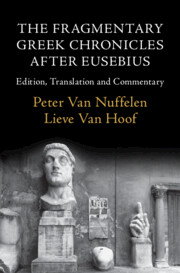Refine search
Actions for selected content:
59 results
New data on globally threatened pear species (Pyrus spp.) in Armenia
-
- Journal:
- Oryx , First View
- Published online by Cambridge University Press:
- 03 November 2025, pp. 1-4
-
- Article
-
- You have access
- Open access
- HTML
- Export citation

The Fragmentary Greek Chronicles after Eusebius
- Edition, Translation and Commentary
-
- Published online:
- 11 September 2025
- Print publication:
- 24 July 2025
Lightning-Sword and Blazing Steed under the Hammer and Sickle: The Rebirth of David of Sassoun in Soviet Armenia
-
- Journal:
- Nationalities Papers , FirstView
- Published online by Cambridge University Press:
- 30 July 2025, pp. 1-27
-
- Article
-
- You have access
- Open access
- HTML
- Export citation
111 - Pseudo-Epiphanius of Salamis, Chronicle
-
- Book:
- The Fragmentary Greek Chronicles after Eusebius
- Published online:
- 11 September 2025
- Print publication:
- 24 July 2025, pp 457-474
-
- Chapter
- Export citation
100 - Andreas, Brother of Magnus, Chronography
-
- Book:
- The Fragmentary Greek Chronicles after Eusebius
- Published online:
- 11 September 2025
- Print publication:
- 24 July 2025, pp 59-175
-
- Chapter
- Export citation
112 - Heron, Chronography
-
- Book:
- The Fragmentary Greek Chronicles after Eusebius
- Published online:
- 11 September 2025
- Print publication:
- 24 July 2025, pp 475-502
-
- Chapter
- Export citation
Molecular survey of taeniid cestodes with special emphasis on Echinococcus species in free-roaming dogs and wild carnivores in Armenia
-
- Journal:
- Parasitology / Volume 152 / Issue 7 / June 2025
- Published online by Cambridge University Press:
- 03 July 2025, pp. 668-676
-
- Article
-
- You have access
- Open access
- HTML
- Export citation
Textual Layering, Landscape Memory, and Medieval Places in Vayots Dzor, Armenia
-
- Journal:
- European Journal of Archaeology / Volume 28 / Issue 3 / August 2025
- Published online by Cambridge University Press:
- 04 April 2025, pp. 369-390
-
- Article
-
- You have access
- Open access
- HTML
- Export citation
Eighteen - Armenia and Byzantium
- from III - Languages, Confessions, Empire
-
-
- Book:
- Worlds of Byzantium
- Published online:
- 18 October 2024
- Print publication:
- 17 October 2024, pp 590-611
-
- Chapter
- Export citation
Chapter 17 - Hannibal’s Years of Wandering, 190–183
-
- Book:
- Hannibal and Scipio
- Published online:
- 05 September 2024
- Print publication:
- 26 September 2024, pp 369-383
-
- Chapter
- Export citation
Conclusion
-
- Book:
- Persianate Verse and the Poetics of Eastern Internationalism
- Published online:
- 14 December 2023
- Print publication:
- 21 December 2023, pp 197-202
-
- Chapter
- Export citation
3 - Armenia
- from Part II - Country University Governance Profiles
-
-
- Book:
- Governing Universities in Post-Soviet Countries
- Published online:
- 05 October 2023
- Print publication:
- 19 October 2023, pp 35-45
-
- Chapter
-
- You have access
- Open access
- HTML
- Export citation
Chapter 5 - The Treaty of Sèvres
- from Part Three - Making Peace
-
- Book:
- The Last Treaty
- Published online:
- 01 June 2023
- Print publication:
- 15 June 2023, pp 143-169
-
- Chapter
- Export citation
Emergency Medical Services Preparedness in Dual Disasters: War in the Era of COVID-19 in Armenia
-
- Journal:
- Prehospital and Disaster Medicine / Volume 37 / Issue 6 / December 2022
- Published online by Cambridge University Press:
- 04 November 2022, pp. 749-754
- Print publication:
- December 2022
-
- Article
- Export citation
2 - The Australasian Orphanage at Antilyas
- from Part I - Saving
-
- Book:
- The Humanitarians
- Published online:
- 28 July 2022
- Print publication:
- 11 August 2022, pp 51-82
-
- Chapter
- Export citation
Turkey’s “Apology” and Image Repair on the Centennial of the Armenian Genocide
-
- Journal:
- Nationalities Papers / Volume 52 / Issue 1 / January 2024
- Published online by Cambridge University Press:
- 08 June 2022, pp. 167-177
-
- Article
- Export citation
2 - Ethos of the “Slave-Soldiers” Regime
-
- Book:
- The Mamluk Sultanate
- Published online:
- 05 May 2022
- Print publication:
- 26 May 2022, pp 53-79
-
- Chapter
- Export citation
Foregrounding Daily Data Collection on Archaeological Fieldwork
- Part of
-
- Journal:
- Advances in Archaeological Practice / Volume 9 / Issue 4 / November 2021
- Published online by Cambridge University Press:
- 08 November 2021, pp. 402-414
-
- Article
-
- You have access
- HTML
- Export citation
The Psychosocial Impact of Compounding Humanitarian Crises Caused by War and COVID-19 Informing Future Disaster Response
-
- Journal:
- Prehospital and Disaster Medicine / Volume 36 / Issue 5 / October 2021
- Published online by Cambridge University Press:
- 06 August 2021, pp. 501-502
- Print publication:
- October 2021
-
- Article
-
- You have access
- HTML
- Export citation
Bahl Šahastan in the land of the K‘ušans: Medieval Armenian memories of Balkh as an Arsacid capital
-
- Journal:
- Bulletin of the School of Oriental and African Studies / Volume 84 / Issue 1 / February 2021
- Published online by Cambridge University Press:
- 02 March 2021, pp. 19-45
- Print publication:
- February 2021
-
- Article
- Export citation
